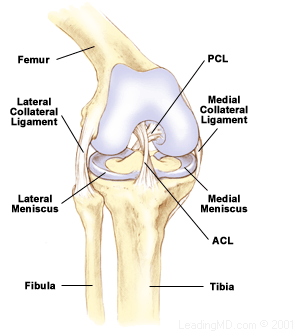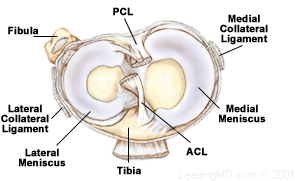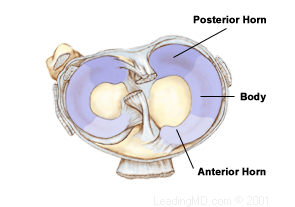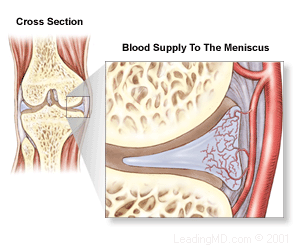|
 The
medial meniscus and lateral meniscus are
specialized structures within the knee. These crescent-shaped shock
absorbers between the tibia and femur have an important role in the
function and health of the knee. Once thought to be of little use,
the menisci (plural) were routinely removed when torn.
Now we know that the menisci contribute to a healthy knee because
they play important roles in joint stability, force transmission,
and lubrication. When possible, they are repaired if injured. There
are even experimental attempts to replace a damaged meniscus, possibly
an important advance in orthopaedic medicine. The
medial meniscus and lateral meniscus are
specialized structures within the knee. These crescent-shaped shock
absorbers between the tibia and femur have an important role in the
function and health of the knee. Once thought to be of little use,
the menisci (plural) were routinely removed when torn.
Now we know that the menisci contribute to a healthy knee because
they play important roles in joint stability, force transmission,
and lubrication. When possible, they are repaired if injured. There
are even experimental attempts to replace a damaged meniscus, possibly
an important advance in orthopaedic medicine.
There are two categories
of meniscal injuries - acute
tears and degenerative tears.
An acute tear usually occurs
when the knee is bent and forcefully twisted, while the leg is
in a weight bearing position. Statistics show that about 61 of
100,000 people experience an acute tear of the meniscus.
Degenerative tears of the
meniscus are more common in older people. Sixty percent of the
population over the age of 65 probably has some sort of degenerative
tear of the meniscus. As the meniscus ages, it weakens and becomes
less elastic. Degenerative tears may result from minor events
and there may or may not be any symptoms present.
What are the menisci?
 The
two menisci of the knee are crescent-shaped wedges that fill the gap
between the tibia and femur. The menisci provide joint stability
by creating a cup for the femur to sit in. The outer edges are fairly
thick while the inner surfaces are thin. If the menisci were missing,
the curved femur would move on the flat tibia. The
two menisci of the knee are crescent-shaped wedges that fill the gap
between the tibia and femur. The menisci provide joint stability
by creating a cup for the femur to sit in. The outer edges are fairly
thick while the inner surfaces are thin. If the menisci were missing,
the curved femur would move on the flat tibia.
The medial meniscus, located on the inside of the knee, is
more of an elongated "C"- shape, as the tibial surface is larger on
that side. The medial meniscus is more commonly injured because
it is firmly attached to the medial collateral ligament and joint
capsule. The lateral meniscus, on the outside of the knee,
is more circular in shape. The lateral meniscus is more mobile
than the medial meniscus as there is no attachment to the lateral
collateral ligament or joint capsule.
 The
outer edges of each meniscus attach to the tibia by the short coronary
ligaments. Other short ligaments attach the ends of the menisci
to the tibial surface. The inner edges are free to move because they
are not attached to the bone. This lets the menisci change shape as
the joint moves. The front portion of the meniscus is referred to
as the anterior horn, the back portion is the posterior
horn, and the middle section is the body. The
outer edges of each meniscus attach to the tibia by the short coronary
ligaments. Other short ligaments attach the ends of the menisci
to the tibial surface. The inner edges are free to move because they
are not attached to the bone. This lets the menisci change shape as
the joint moves. The front portion of the meniscus is referred to
as the anterior horn, the back portion is the posterior
horn, and the middle section is the body.
Under the microscope, the meniscus is fibrocartilage
that has strength and flexibility from collagen fiber.
Its resilience is due to the high water content in the spaces
between the cells. There is not much blood supply to the menisci.  Blood flows only to the outer
edges from small arteries around the joint. The poor blood supply
to the inner portion of the meniscus makes it difficult for the meniscus
to heal.
Blood flows only to the outer
edges from small arteries around the joint. The poor blood supply
to the inner portion of the meniscus makes it difficult for the meniscus
to heal.
What does the meniscus do?
The meniscus acts as a shock absorber for the knee by spreading
compression forces from the femur over a wider area on the
tibia.
- The medial meniscus bears up
to 50% of the load applied to the medial (inside) compartment
of the knee.
- The lateral meniscus absorbs
up to 80% of the load on the lateral (outside) compartment
of the knee.
- During the various phases of the
walking cycle, forces shift from one meniscus to the other, and
forces on the knee can increase to 2 - 4 times body weight.
- While running, these forces
on the knee increase up to to 6 - 8 times body weight. There
are even higher forces when landing from a jump.
The
important role of the meniscus in force transmission can
be seen when the menisci are removed.
- If the menisci are removed, the
forces are no longer distributed over a wide area of the tibia.
Without the medial meniscus,
the tibial contact area is decreased 50 - 70%. This
means the same forces from the femur are concentrated on a smaller
area of the tibia.
- When the lateral meniscus is removed,
there is a 45 - 50% decrease in contact area. This results
in a 200 - 300% increase in contact pressure, which can eventually
damage the cartilage on the ends of the bones.
This can lead to degenerative arthritis.
In the 1960s and 1970s, it was common to remove a damaged meniscus entirely.
This frequently led to early degenerative arthritis in many
patients.
- Removing the entire medial meniscus can lead to a bow-legged deformity and medial joint arthritis.
- Removing the entire lateral meniscus can cause a knock-kneed deformity and lateral joint arthritis.
What
is a meniscus injury?
Patients describe meniscal tears in a variety of ways. Knowing where
and how a meniscus was torn helps the doctor determine the
best treatment.
-
 Location
-A tear may be located in the anterior horn, body, or posterior
horn. A posterior horn tear is the most common. The meniscus is
broken down into the outer, middle, and inner thirds. The third
in which the tear is located will determine the ability of the
tear to heal, since blood supply in that area is critical to the
healing process. Tears in the outer 1/3 have the best chance
of healing. Location
-A tear may be located in the anterior horn, body, or posterior
horn. A posterior horn tear is the most common. The meniscus is
broken down into the outer, middle, and inner thirds. The third
in which the tear is located will determine the ability of the
tear to heal, since blood supply in that area is critical to the
healing process. Tears in the outer 1/3 have the best chance
of healing.
- Pattern -
Meniscal tears come in many shapes. The pattern of the tear influences
the doctor's decision on treatment. Examples of the various patterns
are:
A
complex tear includes more than one pattern.
-
Completeness
- A tear is classified as being complete or incomplete. A tear is
considered complete
if it goes all the way through the meniscus and a piece of the tissue
is separated from the rest of the meniscus. If the tear is still partly
attached to the body of the meniscus, it is considered incomplete.
-
Stability
- A tear can be stable or unstable. A
stable tear does not move and may heal on its own. An
unstable tear allows the meniscus to move abnormally
and is likely to be a problem if it is not surgically corrected.

© 2015 by LeadingMD.com All rights reserved.
Disclaimer
|
|
Stem cells, PRP, and HA, oh my! We are not in Kansas anymore… Part 2
READ MORE >>
|
|
|
|

